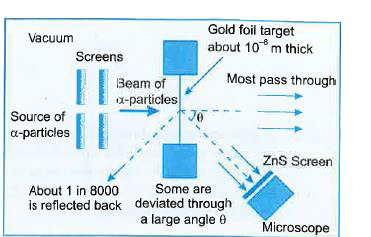Draw a schematic arrangement of Geiger-Marsden experiment showing the scattering of C-particles by a thin foil of gold. Why is it that most of the O-particles go right through the foil and only a small fraction gets scattered at large angles ?
A schematic arrangement of the Geiger-Marsden experiment is shown in Fig. 12.11.
In their experiment it was observed that most of the alpha-particles pass through the gold foil without any appreciable deflection. Some a particles are scattered through different angles and a very small number of particles suffers large angle scattering of about 180∘
Large angle scattering can be explained if we consider the entire positive charge and almost whole mass of gold foil atom to be concentrated in a tiny central core of the atom. When an α-particle with kinetic energy K approaches the gold nucleus directly along its central line it slows down, as it approaches the a-particles gold nucleus, due to coulombian repulsion force between nucleus and α-particle. The α -particle can come up to a certain minimum distance is called the distance of closed approach . Obviously value of distance of closest approach provides the upper limit on the size of the nucleus .

Related Playlists
- BOOK - U-LIKE SERIESCHAPTER - ATOMSEXERCISE - LONG ANSWER QUESTIONS - II4videos
ATOMS
- BOOK - U-LIKE SERIESCHAPTER - ATOMSEXERCISE - SELF ASSESSMENT TEST (SECTION A( MULTIPLE CHOICE QUESTIONS))5videos
ATOMS
- BOOK - U-LIKE SERIESCHAPTER - ATOMSEXERCISE - SHORT ANSWER QUESTIONS30videos
ATOMS
- BOOK - U-LIKE SERIESCHAPTER - ALTERNATING CURRENT EXERCISE - SELF ASSESSMENT TEST (SECTION -C)2videos
ALTERNATING CURRENT
- BOOK - U-LIKE SERIESCHAPTER - CBSE EXAMINATION PAPER 2020 EXERCISE - SECTION D12videos
CBSE EXAMINATION PAPER 2020
Similar Questions
Draw a schematic arrangement of the Geiger-Marsden experiment. How did the scattering of a-particles by a thin foil of gold provide an important way to determine an upper limit on the size of the nucleus ? Explain briefly.
View SolutionDraw a schematic arrangement of the Geiger Marsden experiment. How did the scattering of α particles by a thin foil of gold provide an important way to determine an upper limit on the size of nucleus? Explain briefly.
View SolutionDraw a schematic arrangement of the Geiger Marsden experiment. How did the scattering of α particles by a thin foil of gold provide an important way to determine an upper limit on the size of nucleus? Explain briefly.
View SolutionIn the study of Geiger-Marsden experiment on scattering of alpha particles by a thin foil of gold, draw the trajectory of alpha-particles in the coulomb field of target nucleus, Explain briefly how one gets the information on the size of the nucleus from this study.
View SolutionWhen alpha particles are sent through a thin metal foil, most of them go straight through the foil because:
View SolutionWhen alpha particle are sent through a thin metal foil ,most of them go straight through the foil because
View SolutionWhen alpha particle are sent through a thin metal foil ,most of them go straight through the foil because
View SolutionWhen alpha particles are sent through a thin metal foil, most of them go straight through the foil because
View SolutionWhen alpha particle are sent through a thin metal foil ,most of them go straight through the foil because
View SolutionWhen alpha particle are sent through a thin metal foil ,most of them go straight through the foil because
View Solution

